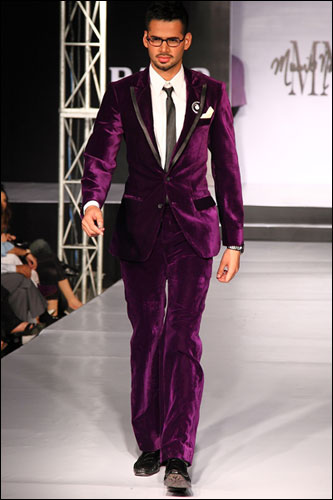
Munib Nawaz’s debut solo show was a declaration of masculine identity, something that was proudly declared in the fact that this was the first solo menswear show taking place within Pakistan in the past twenty five years. It came five years after the menswear designer had formally launched his label (though he has been dabbling in fashion much longer), 97 music videos after he had taken a lateral route to recognition by designing wardrobes for musicians and several months after hitting the runways of Miami Fashion Week, bringing back an award for Best Menswear Designer. Munib really has never been slotted in the top tier of men’s fashion in Pakistan but with this show, he proved that he has all the right to rock on up.
Ironically, the one element to Munib Nawaz’s fame – his dark and almost twisted signature – has also been the one thing keeping him from rising to levels other menswear designers in Pakistan enjoy. How many people in Pakistan can identify with chains weaving the lower half of a formal suit, or red velvet hoods erupting from the collar of another, almost like a burst of uncontrollable lava? Not many people want to dress like ‘them quirky musicians’ in Pakistan either and by consistently designing for them, Munib has built a reputation for theatrics, fashion that has always been more costume than classic.

And that is exactly what he wanted to fix that night at the show. This wasn’t a fashion show devised to prove how creative he is, rather a show to prove that he can be just as straight. This collection was neither metal heavy nor blood-thirsty. The drama was limited to a row of studs on the cuff or a satin cravat exploding on the lapel of an otherwise classic suit like the result of a gunshot. The surprises were hidden in the unexpected crimson lining of an elongated jacket or an unexpected third pocket on a cropped coat. This collection was creative, yes, but it also knew its limitations and refrained from tipping the scales of flamboyance.
The entire evening was free of flamboyance, in fact. People expecting theatrics were disappointed as the rising bubble of Munib’s whakiness fell flat on this plain debut solo show. But Munib was unapologetic. For him, this much-needed stability of a straightforward sixty piece collection was exactly what was required to build his business. He had acquired the fame, he felt, and now it was time to invest in the fortune. He played it safe with this debut, displaying on a smorgasbord of menswear, everything that he was capable of creating.
Cocktail suits flirted with classicism from the fifties in a very Marlon Brando way. They began with luxurious black satin and sailed through mafia friendly pinstripes, either in formal suiting or simply on waistcoats worn over white shirts. The only thing missing was a Cuban cigar. Accessories were, however, restricted to wrist wtahces which one suspects came from Rado, sponsors of the show.
The structure of the collection was altogether streamlined with no fuss on the well-fitted straight trousers and almost body-sculpted jackets. This collection very clearly crossed out casual bagginess as part of the male dressing room regime. It cut no slack to tardiness. The most avant garde of suits was the purple velvet two-piece, a work of art suggestive of a quirky Willy Wonka character, and nonetheless intriguing. Could this begin a trend for purple suits: one believes it most certainly could.

While Munib’s western pieces strongly managed to herald new trends, the traditional line fell short of making any substantial impression. Sherwanis are the male counterpart of bridal ghararas, always repetitive in design and monotonous to watch on a fashion runway. And while Munib – like every other designer – did manage to cut out some interesting hybrids, they were at the end of the day over shadowed by embellishment for variation. And it wasn’t the kind of hand embroidered finery that can be ruled into the best around. That said, a couple of sherwanis – especially one inspired by a cutaway morning coat – were perfect in their razor sharp finish.

The minor weaknesses in this collection are things one can easily overlook because the route Munib Nawaz has taken to be where he stands today promises to lead him even further. This is someone who started extremely humble -“I stepped into this business with only a thousand rupees in my pocket,” he says – and one has witnessed him tread with unerring optimism. He’s one of the rare people in fashion who have an aura of positivity around them, a humane quality that has him puffing in anxiety before a show and jumping in childish delight afterwards. His desire to grow comes from his need to grow and thus he does so with an honesty that is delightful to watch.
“I always had a five year plan,” he told Instep at the show, adding that “I like to talk about things after they have been accomplished. But my aim was to build my brand identity in five years, which is where the TV programs (he has hosted several shows) and the music videos helped. And going to Miami Fashion Week was part of that plan. I ideally wanted to go to New York Fashion Week but it isn’t easy to get on that platform. They deferred me to 2013. The next five years will be about expansion and I see 500 outlets, not just in Pakistan.” Munib Nawaz is thinking ‘world’ and after impressing the critics in Miami – he came back with Best Menswear Award for his Ideology Collection – Munib certainly is ready to take on more.
–Photography by Ayaz Anis
Review by By Aamna Haider Isani
Source : Instep Magazine


I really liked your blog post.Really looking forward to read more. Much obliged.